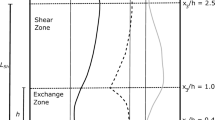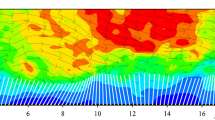Abstract
Displacement height (d) is an important parameter in the simple modelling of wind speed and vertical fluxes above vegetative canopies, such as forests. Here we show that, aside from implicit definition through a (displaced) logarithmic profile, accepted formulations for d do not consistently predict flow properties above a forest. Turbulent transport can affect the displacement height, and is an integral part of what is called the roughness sublayer. We develop a more general approach for estimation of d, through production of turbulent kinetic energy and turbulent transport, and show how previous stress-based formulations for displacement height can be seen as simplified cases of a more general definition including turbulent transport. Further, we also give a simplified and practical form for d that is in agreement with the general approach, exploiting the concept of vortex thickness scale from mixing-layer theory. We assess the new and previous displacement height formulations by using flow statistics derived from the atmospheric boundary-layer Reynolds-averaged Navier–Stokes model SCADIS as well as from wind-tunnel observations, for different vegetation types and flow regimes in neutral conditions. The new formulations tend to produce smaller d than stress-based forms, falling closer to the classic logarithmically-defined displacement height. The new, more generally defined, displacement height appears to be more compatible with profiles of components of the turbulent kinetic energy budget, accounting for the combined effects of turbulent transport and shear production. The Coriolis force also plays a role, introducing wind-speed dependence into the behaviour of the roughness sublayer; this affects the turbulent transport, shear production, stress, and wind speed, as well as the displacement height, depending on the character of the forest. We further show how our practical (‘mixing-layer’) form for d matches the new turbulence-based relation, as well as correspondence to previous (stress-based) formulations.








Similar content being viewed by others
Notes
Some formulations for displacement height also attempt to describe mean scalar profiles (e.g. Thom et al. 1975).
We introduce the friction velocity \(u_{*}\) via the mean momentum flux \(\left\langle {{u}^{\prime }{w}^{\prime }} \right\rangle =-u_*^{2}\), where turbulent fluctuations about the mean are denoted by primes.
The Lambert-W function is sometimes labelled the ‘product-log’ function; see e.g. Warburton and Wang (2004).
\(z_{0,sfc} \left\langle {{u}^{\prime }{w}^{\prime }} \right\rangle _{0}\ll h\left\langle {{u}^{\prime }{w}^{\prime }} \right\rangle _\mathrm{h}\) is valid in the mean, since Brunet et al. (1994) confirmed that \(\left\langle {{u}^{\prime }{w}^{\prime }} \right\rangle _{0}\ll \left\langle {{u}^{\prime }{w}^{\prime }} \right\rangle _\mathrm{h}\) experimentally, and the roughness length \(z_{0,sfc} \) is much smaller than the canopy height h.
References
Apsley DD, Castro IP (1997) A limited-length-scale \(k-\varepsilon \) model for the neutral and stably-stratified atmospheric boundary layer. Boundary-Layer Meteorol 83:75–98
Arnqvist J, Bergstrom H (2015) Flux-profile relation with roughness sublayer correction. Q J R Meteorol Soc 141:1191–1197
Bache DH (1986) Momentum transfer to plant canopies: influence of structure and variable drag. Atmos Environ 20(7):1369–1378
Boy M, Sogachev A, Lauros J, Zhou L, Guenther A, Smolander S (2011) SOSA - a new model to simulate the concentrations of organic vapours and sulphuric acid inside the ABL - Part 1: Model description and initial evaluation. Atmos Chem Phys 11:43–51
Brunet Y, Finnigan JJ, Raupach MR (1994) A wind tunnel study of air flow in waving wheat: single-point velocity statistics. Boundary-Layer Meteorol 70:95–132
Dellwik E, Jensen NO (2005) Flux-profile relationships over a fetch limited beech forest. Bound-Layer Meteorol 115:179–204
Finnigan JJ, Brunet Y (1995) Turbulent airflow in forests on flat and hilly terrain. In: Coutts MP, Grace J (eds) Wind and trees. Cambridge University Press, London, pp 3–40
Foken T (2004) 50 Years of the Monin-Obukhov Similarity Theory. In: 16th symposium on boundary layers and turbulence. American Meteorological Society, Portland, Fundamental studies of turbulence: observations, theory, and models session (7.1)
Garratt JR (1978) Flux profile relations above tall vegetation. Q J R Meteorol Soc 104:199–211
Garratt JR (1979) Comments[II] on ‘Analysis of flux-profile relationships above tall vegetation–alternative view’. Q J R Meteorol Soc 105(446):1079–1082
Grønnegaard JP, Gryning SE, Kelly M (2014) On the structure and development of inversion-capped neutral atmospheric boundary-layer flows: large-eddy simulation study. Boundary-Layer Meteorol 153:43–62
Harman IN, Finnigan JJ (2007) A simple unified theory for flow in the canopy and roughness sublayer. Boundary-Layer Meteorol 123:339–363
Hicks BB, Hess GD, Wesely ML (1979) Analysis of flux-profile relationships above tall vegetation–alternative view. Q J R Meteorol Soc 105(446):1074–1077
Högström U (1996) Review of some basic characteristics of the atmospheric surface layer. Boundary-Layer Meteorol 78:215–246
Jackson PS (1981) On the displacement height in the logarithmic velocity profile. J Fluid Mech 111:15–25
Kelly M, Larsen GC, Dimitrov NK, Natarajan A (2014) Probabilistic meteorological characterization for turbine loads. J Phys: Conf Ser 524(1):012076
Kolmogorov AN (1941) The local structure of turbulence in incompressible viscous fluid for very large Reynolds numbers. Proc. USSR Acad. Sci. (Russian; Tr. Akad. Nauk. SSSR) 30: 299–303. Translated into English by V. Levin (1990). Proc R Soc A 434:9–13
Landsberg JJ, Jarvis PG (1973) A numerical investigation of the momentum balance of a spruce forest. J Appl Ecol 10:645–655
Mammarella I, Dellwik E, Jensen NO (2008) Turbulence spectra, shear stress, and turbulent kinetic energy budgets above two beech forest sites in Denmark. Tellus 60(B):179–187
Meyers T, Paw-U KT (1986) Testing of a higher-order closure model for modeling airflow within and above plant canopies. Boundary-Layer Meteorol 37:297–311
Monin AS, Obukhov AM (1954) Basic laws of turbulent mixing in the surface layer of the atmosphere. Tr Akad Nauk SSSR Geofiz Inst 24:163–187
Monin AS, Yaglom AM (1971) Statistical fluid mechanics: mechanics of turbulence, vol 1. English version ed. J.Lumley. MIT Press, Cambridge, 769 pp
Nakamura R, Mahrt L (2001) Similarity theory for local and spatially averaged momentum fluxes Agric. Forest Meteorol 108:265–279
Panferov O, Sogachev A (2008) Influence of gap size on wind damage variables in a forest. Agric For Meteorol 148:1869–1881
Pope SB (2000) Turbulent flows. Cambridge University Press, Cambridge, 771 pp
Poggi D, Katul GG, Albertson JD (2004) Momentum transfer and turbulent kinetic energy budgets within a dense model canopy. Boundary-Layer Meteorol 111:589–614
Raupach MR (1979) Anomalies in flux-gradient relationships over forest. Bound-Layer Meteorol 16:467–486
Raupach MR, Stewart JB, Thom AS (1979) Comments[I] on ‘Analysis of flux-profile relationships above tall vegetation–alternative view’. Q J R Meteorol Soc 105(446):1077–1078
Raupach MR, Thom AS (1981) Turbulence in and above plant canopies. Annu Rev Fluid Mech 13:97–129
Raupach MR, Coppin PA, Legg BJ (1986) Experiments on scalar dispersion in a model plant canopy. Part I: the turbulent structure. Boundary-Layer Meteorol 35:21–52
Raupach MR, Finnigan JJ, Brunet Y (1996) Coherent eddies and turbulence in vegetation canopies: the mixing-layer analogy. Boundary-Layer Meteorol 78:351–382
Seginer I, Mulhearn PJ, Bradley EF, Finnigan JJ (1976) Turbulent flow in a model plant canopy. Boundary-Layer Meteorol 10:423–453
Shaw RH, Pereira AR (1982) Aerodynamic roughness of a plant canopy: a numerical experiment. Agric Meteorol 26:51–65
Simpson IJ, Thurtell GW, Neumann HH, Den Hartog G, Edwards GC (1998) The validity of similarity theory in the roughness sublayer above forests. Boundary-Layer Meteorol 87:69–99
Sogachev A, Panferov O (2006) Modification of two-equation models to account for plant drag. Boundary-Layer Meteorol 121:229–266
Sogachev A, Menzhulin G, Heimann M, Lloyd J (2002) A simple three dimensional canopy—planetary boundary layer simulation model for scalar concentrations and fluxes. Tellus 54B:784–819
Sogachev A, LeClerc MY, Karipot A, Zhang G, Vesala T (2005) Effect of clearcuts on footprints and flux measurements above a forest canopy. Agric Forest Meteorol 133:182–196
Sogachev A, Leclerc MY, Zhang G, Rannik Ü, Vesala T (2008) CO2 fluxes near a forest edge: a numerical study. Ecol Appl 18:1454–1469
Sogachev A, Kelly M, Leclerc MY (2012) Consistent two-equation closure modeling for atmospheric research: Buoyancy and vegetation implementations. Boundary-Layer Meteorol 145:307–327
Thom AS (1971) Momentum Absorption by Vegetation. Q J R Meteorol. Soc 97:414–428
Thom AS, Stewart JB, Oliver HR, Gash JHC (1975) Comparison of aerodynamic and energy budget estimates of fluxes over a pine forest. Q J R Meteorol Soc 101:93–105
Warburton RDH, Wang J (2004) Analysis of asymptotic projectile motion with air resistance using the Lambert W function. Amer J Phys 72:1404–1410
Wilcox DC (2002) Turbulence modeling for CFD. DCW Industries Inc, La Cañada 460 pp
Wilson JD, Finnigan JJ, Raupach MR (1998) A first-order closure for disturbed plant canopy flows, and its application to windflow through a canopy on a ridge. Q J R Meteorol Soc 124:705–732
Wooding RA (1968) A low speed wind tunnel for model studies in micrometeorology. II. The Pye laboratory wind tunnel. Aust CSIRO Div Plant Ind Tech Pap 25:1–24
Wyngaard JC (2004) Toward numerical modelling in the “Terra Incognita”. J Atmos Sci 61:1816–1826
Wyngaard JC (2010) Turbulence in the atmosphere. Cambridge University Press, New York 392 pp
Zeman O (1981) Progress in the modelling of planetary boundary layers. Annu Rev Fluid Mech 13:253–272
Acknowledgments
Part of this work was supported by the Center for Computational Wind Turbine Aerodynamics and Atmospheric Turbulence, funded by the Danish Council for Strategic Research (‘DSF’) under grant number 09-067216. The authors would also like to thank the anonymous reviewers for constructive comments, as well as continued discussion on this subject.
Author information
Authors and Affiliations
Corresponding author
Ethics declarations
Conflict of Interest
The authors (AS and MK) declare that they have no conflict of interest with regards to this work.
Rights and permissions
About this article
Cite this article
Sogachev, A., Kelly, M. On Displacement Height, from Classical to Practical Formulation: Stress, Turbulent Transport and Vorticity Considerations. Boundary-Layer Meteorol 158, 361–381 (2016). https://doi.org/10.1007/s10546-015-0093-x
Received:
Accepted:
Published:
Issue Date:
DOI: https://doi.org/10.1007/s10546-015-0093-x




